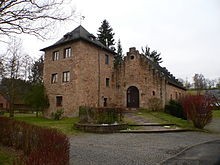Hausen Castle (Bad Soden)
The Schloss Hausen in Hesse Bad Orb goes to the Burghausen near the village of Hausen (Husen) at the same point back.
investment
Today's Schloss Hausen was originally designed as a moated or tower hill castle , probably to secure access to the nearby Fulda possessions. Possibly the name of the field " houses" testifies to a (today past) Landwehr , consisting of Gebück and / or Landgraben .
The spacious castle complex is described for the first time in a directory created in 1540 on the occasion of the sale to Mainz. In addition to the central tower and bower, the palace also had numerous farm buildings, including sheep stables and a mill. The administrative building of the official cellar, built in 1581, has been preserved in its original state, while the old tithe barn (built around 1530) was renovated and rebuilt by a private investor in 2004–2008.
history
Castle phase
The place is first mentioned in 1319 as Husen . The mention was made in connection with a donation from the Fulda abbot to the Salmünster hospital, to which the fallen fiefdom of Vogtes Konrad belonged. Konrad came from the family of those von Jazza and Jossa , who are considered to be the builders of Hausen Castle.
In 1345 Friedrich von Hutten bought the goods at Hausen. However, the property disintegrated due to inheritance divisions, pawn shops and partial sales, so that the shareholders were repeatedly forced to appoint arbitration tribunals to settle the disputes between them. In 1430 Hans von Hutten zum Stolzenberg acquired the ownership rights of his cousins from the Franconian line of those of von Hutten and thus established a third lineage, namely that of the Lords of Hutten zu Hausen.
In order to consolidate their family, the men joined von Hutten to Stolzenberg with their cousins Hausen 1517 a new truce . However, Frowin von Hutten soon lost his property in Hausen: His role in the war of knights cost him all possessions for a short time in 1522. It was not until 1526 that he succeeded in acquiring it back. However, shortly before his death in 1529, Frowin overwritten his stake in Hausen, much to the annoyance of the Stolzenbergers, the competing Franconian relatives. The disputes between the two lines finally led to the sale of the Franconian shares in Kurmainz (1540).
Lock phase
The Archbishop of Mainz, Daniel Brendel von Homburg , achieved the final balance with the Hutten neighbors in 1558. Hausen Castle was transformed into a palace and became the administrative seat.
In the 18th century the Oberamt Hausen lost its importance until the official seat was relocated to Orb at the end of the century .
Contemporary use
The dilapidated castle complex was bought up by the European Film Union in the early 1950s and subjected to extensive renovations. The established hotel business had to be closed in 1955 due to financial problems of the investor, and the castle changed hands again. The facility has belonged to the Christian Youth Village Association in Germany since 1981 .
literature
- Author collective: Salmünster. From the past of an old town in the Kinzig valley. Festive edition on the occasion of the 650th anniversary of the city's renunciation, o. O. 1970.
- Georg-Wilhelm Hanna : Castles and palaces in the Kinzig valley . Hanau 1992.
Coordinates: 50 ° 16 ′ 12.1 ″ N , 9 ° 22 ′ 50.9 ″ E

